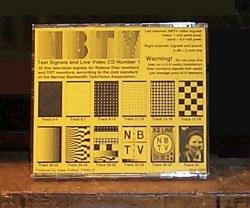
The trick is to use a CD 'ripper' -- software that grabs music tracks off CD (for the club CD is a true 'music' CD, only the music contains encoded NBTV video/sound). Use the ripper to grab the tracks to your hard drive in 'WAV' format. Ripper software is very easy to find and use -- I used <a href="http://www.nch.com.au/rip/index.html">Express Rip</a>, which just happened to be the first one I noted when searching.
Now it's time to visit Gary Millard's fine <a href="http://users.tpg.com.au/users/gmillard/nbtv.htm">Early Television Techniques</a> website and download the program labeled NBTV - The Big Picture! This is an awesome little program that allows us to load the sound programs that we've ripped from the CD, and view the results on our PC.
Now Gary's programming is obviously excellent, but I'm not too keen on his user-interface design. It took me a bit of playing to figure out how to get this program to work (and I still can't figure out how the one labeled 'NBTVA CD Viewer - prototype 3' works!!). I'm guessing that the CD viewer does exactly what I'm showing how to do here. Maybe. IN any case, we're going to use his other program, The BIG Picture...
After installing "NBTV - The BIG Picture", run it. First thing is to load an audio (.WAV) file ripped from our club CD. To do this, select the File->Source->Audio File option, as highlighted in this image....

When you do this, a dialog will open asking you for an audio file. Select one of the WAV files you just ripped from the club CD. The next thing to do is start the video playing. To do that, click the capture button, or select from the menu Action->Capture Video (or hit Ctrl+D). The software will begin 'playing' the video, but what you see may be garbled. You should be able to correct this by playing with the controls at the bottom -- in particular, note where I have the level (labeled in white on light grey, nice!) and the Sync sliders set.

That's about all you need to do -- if you want to load another audio file you will need to turn off the capture video first.
An extremely useful bit of software -- many, many thanks to Gary for writing it. I bitch about the user interface, and it surely could be better. But the software does the job I need it to do, and who am I to complain
Cheers
A
